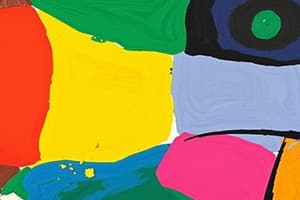Podcast
Questions and Answers
What is the primary focus of art history?
What is the primary focus of art history?
- The chronological development of art forms and artists (correct)
- The techniques used in creating artworks
- The emotional response to art
- The subjective experience of artworks
Which of the following best describes the nature of art as cultural?
Which of the following best describes the nature of art as cultural?
- Art reflects society's beliefs, values, and traditions (correct)
- Art exists independently of social contexts
- Art expresses universal human emotions only
- Art is a product of individual artists' imaginations
In what way does art involve experience?
In what way does art involve experience?
- It only focuses on visual elements like color and shape
- It provides a historical narrative of events
- It engages artists and viewers emotionally and personally (correct)
- It solely stimulates intellectual engagement
Which of the following is NOT a form of 2D visual art?
Which of the following is NOT a form of 2D visual art?
What elements does visual art primarily use to evoke ideas and emotions?
What elements does visual art primarily use to evoke ideas and emotions?
What distinguishes art appreciation from art history?
What distinguishes art appreciation from art history?
How can art be considered universal?
How can art be considered universal?
What is a key component of printmaking?
What is a key component of printmaking?
What does three-dimensional (3D) art use to create tangible artworks?
What does three-dimensional (3D) art use to create tangible artworks?
Which of the following is an example of installation art?
Which of the following is an example of installation art?
What aspect does the physical function of art emphasize?
What aspect does the physical function of art emphasize?
According to Plato, what does art distract individuals from?
According to Plato, what does art distract individuals from?
How did Aristotle's view of art differ from Plato's perspective?
How did Aristotle's view of art differ from Plato's perspective?
Which function of art aims to encourage community dialogue?
Which function of art aims to encourage community dialogue?
What is the main premise of the philosophical perspective of art as imitation?
What is the main premise of the philosophical perspective of art as imitation?
Which of the following best describes installation art?
Which of the following best describes installation art?
What are the two main purposes of art according to Aristotle?
What are the two main purposes of art according to Aristotle?
How did Kant differentiate aesthetic judgments from personal judgments?
How did Kant differentiate aesthetic judgments from personal judgments?
What was Leo Tolstoy’s view on the role of art?
What was Leo Tolstoy’s view on the role of art?
Which of the following best describes representational art?
Which of the following best describes representational art?
What is a characteristic of non-representational art?
What is a characteristic of non-representational art?
According to Aristotle, what aspect of tragedy, like 'Oedipus Rex,' reflects the complexities of human nature?
According to Aristotle, what aspect of tragedy, like 'Oedipus Rex,' reflects the complexities of human nature?
What is meant by 'disinterested judgment' in Kant's philosophy of art?
What is meant by 'disinterested judgment' in Kant's philosophy of art?
Which of the following statements reflects a common misconception about art according to the content?
Which of the following statements reflects a common misconception about art according to the content?
What does 'Sources of Subject' refer to in the context of art?
What does 'Sources of Subject' refer to in the context of art?
Which example best represents the theme of 'Nature' in art?
Which example best represents the theme of 'Nature' in art?
What is the primary focus of 'Content in Art'?
What is the primary focus of 'Content in Art'?
Which level of meaning pertains to the viewer's personal experiences and beliefs influencing their understanding of art?
Which level of meaning pertains to the viewer's personal experiences and beliefs influencing their understanding of art?
Which of the following best illustrates the 'Symbolic' level of meaning in art?
Which of the following best illustrates the 'Symbolic' level of meaning in art?
Which statement about 'Historical' sources of subject is accurate?
Which statement about 'Historical' sources of subject is accurate?
What type of artwork would typically convey a 'Literal' level of meaning?
What type of artwork would typically convey a 'Literal' level of meaning?
How does an artist's 'Personal Experiences' influence their artwork?
How does an artist's 'Personal Experiences' influence their artwork?
Study Notes
Arts: Creativity and Imagination
- Art history and art appreciation are distinct fields; the former analyzes the chronological development of art and its historical significance, while the latter emphasizes personal interpretation and emotional responses to artworks.
Basic Assumptions of Art
- Art as Universal: Communicates emotions and ideas that transcend cultures, reflecting shared human experiences such as love and struggle.
- Art as Cultural: Mirrors society’s beliefs and traditions; influenced by historical events and social norms, requiring cultural context for proper interpretation.
- Art Involves Experience: Engages viewers emotionally, stimulating the senses and allowing exploration of emotions, shaping perceptions through active engagement.
Visual Art Forms
- 2D Visual Arts: Art with only height and width, created on flat surfaces like paper or canvas.
- Painting: Uses pigments to convey scenes and emotions.
- Drawing: Involves creating images with tools like pencils or charcoal, ranging from realistic to abstract styles.
- Printmaking: Techniques like etching and screen printing to reproduce artwork.
- 3D Visual Arts: Art that includes height, width, and depth, creating tangible forms.
- Sculpture: Manipulation of materials such as stone or clay into three-dimensional figures.
- Architecture: The design and construction of buildings and structures.
- Installation Art: Large-scale artworks meant for specific locations, using diverse materials.
Functions of Art
- Physical Function: Provides tangible value (e.g., artist-designed chairs that incorporate artistic elements).
- Social Function: Addresses public issues, fostering community pride through public art (e.g., murals depicting cultural diversity).
- Personal Function: Serves as a means of self-expression and introspection (e.g., self-portraits conveying personal emotions).
Philosophical Perspectives on Art
- Art as Imitation: Plato’s view of art as a distraction from the pursuit of truth and virtue; art merely imitates imperfect forms.
- Art as Representation: Aristotle believed art can reveal deeper truths and emotional realities, offering pleasure and lessons about life's complexities.
- Art as Disinterested Judgment: Kant’s philosophy emphasizes objective contemplation of art's universal aesthetic qualities, separate from personal preferences.
- Art as Communication of Emotion: Tolstoy saw art as a medium for sharing emotions, connecting artist and audience.
Subject and Content in Art
- Subject Types:
- Representational Art: Depicts recognizable objects and scenes (e.g., portraits, landscapes).
- Non-Representational Art: Uses forms and colors to evoke emotions without recognizable subjects (e.g., Abstract Expressionism).
- Sources of Subject:
- Personal Experiences: Captures the artist’s emotions and memories (e.g., Frida Kahlo’s self-portraits).
- Nature: Reflects the beauty of the natural world (e.g., landscapes).
- History: Documents and critiques historical events (e.g., David's "The Death of Marat").
Content and Levels of Meaning
- Content in Art: Refers to the emotions, ideas, and narratives that artworks communicate, shaping viewer interpretation.
- Levels of Meaning:
- Literal Meaning: Surface depiction (e.g., a painting of fruit literally shows fruit).
- Symbolic Meaning: Use of symbols to represent abstract concepts (e.g., a red rose symbolizes love).
- Personal Meaning: Unique interpretations based on the viewer's experiences (e.g., contemporary abstract paintings evoke varied interpretations).
Studying That Suits You
Use AI to generate personalized quizzes and flashcards to suit your learning preferences.
Description
Explore the assumptions and nature of arts focusing on creativity and imagination. This quiz distinguishes between art history and art appreciation, emphasizing their unique approaches to understanding art's impact on society and individual perception. Test your knowledge on how art influences human narratives and ideologies.




